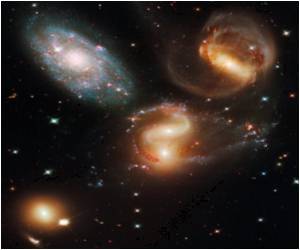An international team of researchers has discovered a pair of supermassive black holes in orbit around one another.

On 10 June 2010, a tidal disruption event was spotted by XMM-Newton in galaxy SDSS J120136.02+300305.5, approximately 2 billion light-years away. Komossa and her colleagues were scanning the data for such events and scheduled follow-up observations just days later with XMM-Newton and NASA's Swift satellite.
The galaxy was still spilling X-rays into space. It looked exactly like a tidal disruption event caused by a supermassive black hole but as they tracked the slowly fading emission day after day something strange happened.
The X-rays fell below detectable levels between days 27 and 48 after the discovery. Then they re-appeared and continued to follow a more expected fading rate, as if nothing had happened.
Now, thanks to Fukun Liu, this behavior can be explained. "This is exactly what you would expect from a pair of supermassive black holes orbiting one another," says Liu.
The findings have been published in the Astrophysical Journal.
Advertisement








